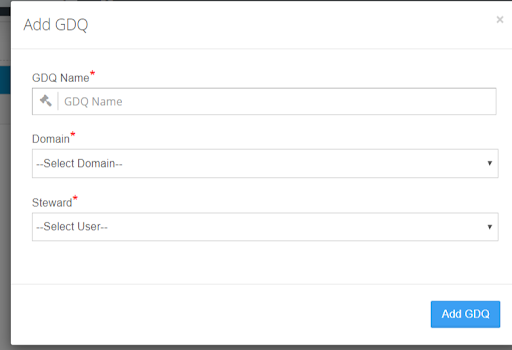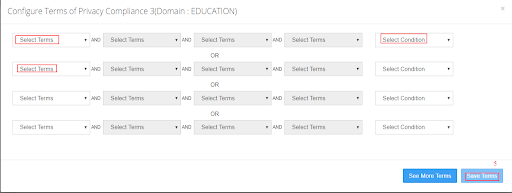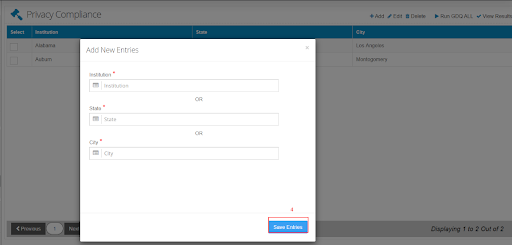Working with GDQ
Stewards and data users need a method to govern the privacy compliance data in OvalEdge. OvalEdge adapts a standard method by using a Governed Data Query search result to search Customer sensitive data.

In OvalEdge each data query is governed across a domain and privacy terms are created under each domain(such as First Name, Last Name, mobile number, and Personal ID). The terms are then associated with the data objects before creating the data Query.
To know how to create a DOMAIN, see <<To create a new Domain>>. To know more about what a business term is and how to create terms, see <<Business Glossary>>. To know how to associate terms to data objects, see <<How to add a glossary term to a data object>>.
Process Flow

Example: Assume the IT team wants to now search customer data by entering his First name, Last name, mobile number, and Personal ID.
He will go to the GDQ module and Create a Governed data Query. Then add the privacy terms and configure the term search conditions. (Here users can search the data with a combination of different privacy terms and values).
Add the configured term search values and execute the GDQ. View the results to see all the associated data objects for this customer.
Governed Data Query Summary Page
The Governed Data Query (GDQ) Summary page displays the list of predefined Data Query names that are created under each domain. It contains information such as GDQ name, Steward (approver who can approve the GDQ), Creation Date, and Created By.
Users can do the following within the Governed Data Query module,
- Create a new GDQ.
- View the list of GDQ’s.
- Configure each GDQ with combinations of privacy terms.
- Update the GDQ configuration with more privacy terms.
- Add entries based on the configured terms to search the customer information.
- Edit the GDQ entries.
- Run or Execute all or specific GDQ search entries.
- View associated data objects for the search result.
- Delete a Governed Data Query.
Creating a Governed Data Query
To create a GDQ in the Governed Data Query Summary Page,
- Go to Governance Catalog >> Governed Data Query.
- Click the
 icon to create a new GDQ.
icon to create a new GDQ.
The add GDQ page opens to create a Governed Data Query.

- On the Add GDQ page, enter the following
- GDQ name-A unique name for the Governed data Query
- Domain- Select the Domain name from the list that has the privacy terms
- b-Approver for the Governed Data Query
- Click
 to create and display the data query on the summary page.
to create and display the data query on the summary page.
Configuring Privacy Terms to Perform a Search
Once the data Query is created, the privacy terms must be configured. To add the privacy terms and set the term conditions,
- Go to Governance Catalog >> Governed Data Query.
- Choose and select a Data Query by clicking the checkbox to the corresponding query.
- Select
 to add the privacy terms with search conditions to build the data Query. OvalEdge provides an option to configure various privacy terms and set multiple search conditions.
to add the privacy terms with search conditions to build the data Query. OvalEdge provides an option to configure various privacy terms and set multiple search conditions. - Add the privacy terms and set conditions. If required, Click see more terms to add another row of terms and conditions.
- Click Save Terms to store the search criteria for the GDQ.

Search Criteria for Privacy terms
You can build complex queries using a combination of privacy terms and operators that can be later set to required values. This page provides information about the operators available for building these queries, and specific conditions for searching terms.
- AND operator- When you enter terms separated by the word "AND," a record will only be found if all the terms you specified are contained somewhere in the associated data objects. For example, if you enter “Gabriel” as your search entry for the term “First name”, and “Dizzosa” as your search entry for the term “Last name”, the result will only display if a record matches both the search conditions.
- OR operator- When you enter terms separated by the word "OR," a record will be found if any of the terms you specified is contained somewhere in the associated data objects. For example, if you enter “Gabriel” as your search entry for the term “First name”, and “Dizzosa” as your search entry for the term “Last name”, the result will display records that match either the first name or the last name or both the entries..
In OvalEdge, configured terms with “AND” conditions execute on all the associated data objects separately. In the same way, configured terms with “OR” conditions execute on all the associated data objects separately.
Note: Users can also choose how the entries should match. Select EQUAL for an exact match or LIKE for all or partial matches.
Editing the terms
Once you configure the Privacy terms and the search conditions, users can add more privacy terms by editing.
To edit and add more terms to a Governed Data Query,
- Go to Governance Catalog >> Governed Data Query.
- Select a Data Query by clicking the checkbox to the corresponding query.
- Select
 to edit the privacy terms and search conditions of the Data Query.
to edit the privacy terms and search conditions of the Data Query. - Add new terms and conditions or edit existing terms and conditions.
- Click
 to update and save the changes.
to update and save the changes.
Search Entries
Once the Privacy terms and conditions are configured, users can add/edit/delete the entries to search customer information.
To add the entries,
- Go to Governance Catalog >> Governed Data Query.
- Click a GDQ name.
- Click
 to add the entries for the configured terms.
to add the entries for the configured terms.
A pop-up window to add new entries is displayed.
- Add the entries and click Save Entries to save.

To Edit the entries,
- Go to Governance Catalog > Governed Data Query.
- Select and click a GDQ name.
- Select the checkbox near the entry to make the changes.
- Click
 to change the entries for the configured terms.
to change the entries for the configured terms.
A pop-up window to Edit entries is displayed.
- Make the changes and click Update Entries to save.
To Delete the entry,
- Go to Governance Catalog > Governed Data Query.
- Select and click a GDQ name.
- Select the checkbox near the entry to delete.
- Click the
 icon to delete the entry.
icon to delete the entry.
A pop-up window asks for the user confirmation to delete the entry.
- Click Confirm to delete the entry.

Executing the Governed Data Query
There can be multiple search entries for a single search criterion. Entries in a single GDQ can be executed in bulk or individually.
To Execute each entry,
- Go to Governance Catalog > Governed Data Query.
- Click a GDQ name.
- Select an entry to execute.
- Click
 .
.
A job is submitted to execute the entry search in the data objects mapped under that domain.
To Execute all the entries at once,
- Go to Governance Catalog > Governed Data Query.
- Click a GDQ name.
- Click the
 to execute all the entries at once.
to execute all the entries at once.
A job is submitted to execute the entry search in the data objects mapped under that domain.
Viewing results of the Governed Data Query
Once the entries are executed, the matched results can be viewed using the View results tab.
To view the results of an entry,
- Go to Governance Catalog > Governed Data Query.
- Click a GDQ name.
- Select an entry.
- Click the
 to see the data objects as a result of the search.
to see the data objects as a result of the search.
A new page opens displaying the list of all the associated data objects that have the information entered in the GDQ.

Each search Entry should be selected individually to view results. Each time the GDQ search entry is executed a data point is created and represented in the line as above. Users can click on the data point to see the earlier results.
Deleting the Governed Data Query
To delete a GDQ,
- Go to Governance Catalog > Governed Data Query.
- Select and click a GDQ name.
- Select the checkbox near the entry to delete.
- Click
 to delete the GDQ.
to delete the GDQ.
A pop-up window opens to ask the user for confirmation to delete the GDQ.
- Click Confirm to Delete the GDQ.
